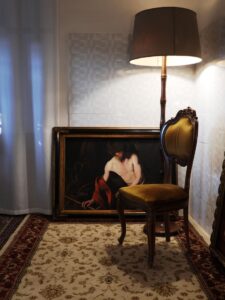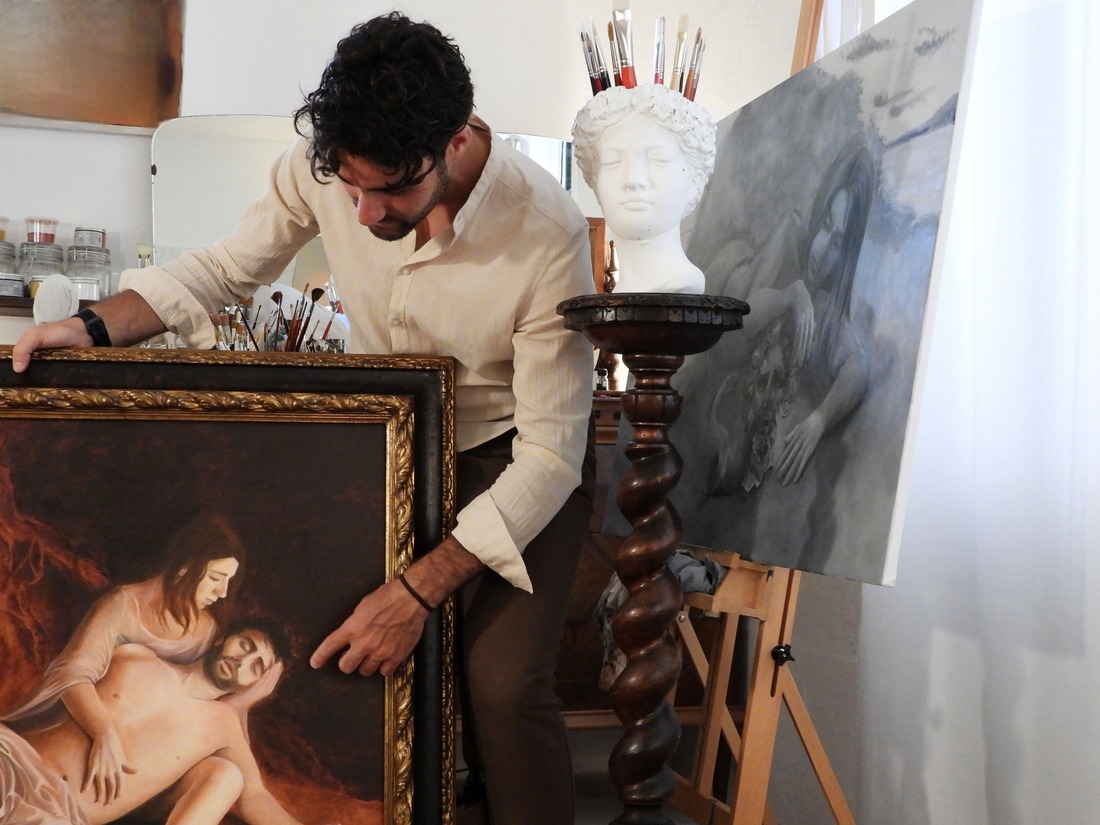By Paola Butera
I had the opportunity to meet Marco Pierini in his studio, and this encounter was not a mere coincidence but rather a deliberate desire to get to know the individual who had captivated me through some of his paintings on Instagram. I must say, reality is even more profound than one might anticipate. Sheets with sketches of figures are hung up, seemingly in pursuit of perfect proportions; brushes and paints are carefully arranged in a corner-these details reveal the meticulous manner in which he conducts his studies. Furthermore, there are canvases resting on the floor, some completed and others still in progress. Light and shadow intermingle with dark hues that dominate the more vibrant colors. Are we witnessing a new Caravaggio? Well, his reserved nature coupled with confidence in his abilities suggests that he has a promising future ahead. Therefore, no, he is not a new Caravaggio, but undoubtedly a talent worthy of attention.
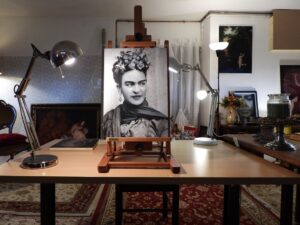
Marco, you pursued an entirely different path before dedicating yourself to art. When did you feel compelled to embark on this artistic journey?
“Since childhood, from my earliest drawings, I experienced a certain emotional connection; I recall seizing every opportunity to draw whenever possible. I remember as if it were yesterday drawing on my school desk during recess and feeling both disappointed to find the desk clean the next day yet simultaneously happy because it meant I could draw on it again. My passion for art, combined with the desire to paint, led me five years ago to enroll in a course to learn various techniques, taught by Master Loris Cardoni, which I attended for three years. Prior to starting the course, I did not possess a solid foundation; thus, I learned several techniques, such as acrylic painting on antique wood, and gained a better understanding of proportions. I began working in black and white to comprehend pigment and how to use it most effectively. From there, a natural evolution towards something more personal arose, marking the beginning of my monochromatic blue journey. Many people told me that my portraits resembled photographs, which motivated me to develop a distinctive style. For me, blue represents the soul of a person; therefore, painting in blue was akin to undertaking an introspective journey. Additionally, it is one of my favourite colours because I associate it with the sea”.
In your studio and gallery in Gubbio, you can see numerous female faces hung on the walls: large canvases alongside smaller ones on easels; blue blends into countless shades and constantly varying poses. I noticed many of your female portraits from the blue phase-did you participate in exhibitions or events during that period? “Yes, I took part in several group exhibitions between 2022 and 2023 here in Gubbio as well as at Must in Lecce and Cesenatico, where I received an international recognition at the “Leonardo da Vinci Award.” I have exhibited in Palermo and in several galleries in Rome. Following that award, new opportunities arose for me: I organized my first solo exhibition at the Relais San Clemente di Bosco near Perugia, followed by two more exhibitions-one in Rimini and the most recent solo exhibition, perhaps the most significant, at the Rocca di Passignano sul Trasimeno, where I presented my entire journey with acrylic painting”.
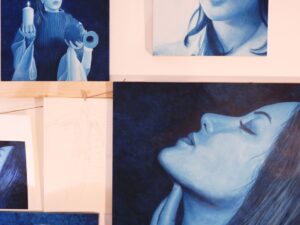
Then everything changed; the artistic evolution took a different direction. Perhaps it was a life change or personal growth that led to greater self-awareness. At a certain point, he felt that change was necessary. But what motivated you to turn to oil painting and the continuous exploration of figurative art? “During this period of learning, I experienced an artistic breakthrough because I noticed positive responses-something I had not anticipated at all. Thus, I decided to deepen my study of anatomy and physiognomy in portraiture even further. Thanks to another master, Andrea Esposito from Rimini, I learned the technique of oil painting. In fact, I have always been fascinated by Renaissance techniques; therefore, I wanted to follow in the footsteps of great masters such as Caravaggio and Leonardo da Vinci, as well as other masters from the Renaissance through to the nineteenth and twentieth centuries like Bouguereau. This new phase of study allowed me to experiment with color and light. I began precisely by replicating a work of Caravaggio: my first oil painting was Saint John the Baptist, a piece to which I am very attached and which I keep here in my studio. Subsequently, I started working on people close to me to study proportions thoroughly; usually, I begin by jotting down all the ideas that come to mind with simple and schematic pencil sketches. Typically, I make quick sketches, around five or ten minutes each, primarily to study poses. Once I find the one that I believe works best, I focus on it and try to define it with slightly more detailed forms”.
I look around and see easels with works just begun or others almost finished, but he always dedicate a bit more time to each one to add a brushstroke, aiming to give depth or play with light. Nothing is left to chance. Your oil paintings seem not only to convey a mood but also almost serve as a kind of medicine for your soul. What do you feel when you work on the canvas? “For me, it is like traveling back in time, immersing myself in that era and working in the manner of the old masters. It was precisely this experience that triggered something within me and made me realize that I wanted to continue along this path and deepen my knowledge. In fact, I began preparing the colours myself by purchasing pigments and processing them as was done in the past. From that point, I also began to develop personal ideas for my paintings. Currently, I am working on a full-length double portrait self-portrait, measuring one meter and eighty centimetres in height, which I have titled “Portae Inferi.” It is a self-portrait in which I am accompanied by a person who is very important to me, someone who was fundamental during one of the most challenging periods of my life. Through this painting, I have truly understood what I want to pursue: conveying my emotions and states of mind within an elegant atmosphere, employing traditional techniques and slow pacing. Each day, I observe the painting with fresh eyes, adding or removing colours and lights; through this process, I feel my soul healing somewhat”.
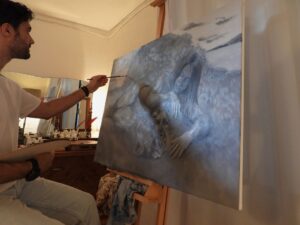
When I approach the painting placed on the floor, illuminated by the warm yellow light of lamps that enhance the ambiance, I see him in her arms as if he has finally found peace. And now? What do you expect from this new journey? “Well, I sincerely hope to make myself known in the art world. I have been fortunate to meet Maestro Ulisse Sartini, one of the great contemporary artists inspired by Renaissance art. He has always been a significant point of reference and a tremendous source of inspiration for me. I would like to follow in his footsteps and above all be recognized as an artist. I still have much to offer; numerous ideas in my mind that take shape as sketches. Among these is a project for a very large canvas, measuring two meters by two and a half meters, which will be my first work featuring multiple figures. This represents a genuine challenge for me to deepen my study of poses and anatomy… however, I prefer not to reveal too much at this stage. It will nonetheless be a more complex introspective journey, during which I intend to test myself by continuing to study and experiment”.
Ambition remains strong, natural talent is present, and now all that remains is to wait with confidence. This extensive introspective journey will lead us to discover what the upcoming solo exhibition has in store for us. There is no rush, as we understand that oil painting requires its precious time to fully reveal its beauty.
Info: marcopierini17@gmail.com / www.marcopierini.it/ IG @marcopierini17 / FB @marco pierini
